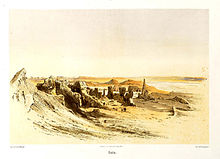Sais, Egypt
Sais | |
|---|---|
UTC+2 (EST ) |

Sais (
| Sais in hieroglyphs | ||||||
|---|---|---|---|---|---|---|
Sau (Zau) Sȝw | ||||||
| Greek | Σάϊς (Sais) | |||||
Neolithic period
A Neolithic settlement has been identified at Sais recently (1999), dating to 5000 BC. Agriculture appears here during this period, as well as at another similar site, Merimde Beni Salama, which is located about 80km south of Sais.[5]
The Neolithic period at Sais consists of three phases. The earliest phases are Early Neolithic (Sais I) and Late Neolithic (Sais II).[6] During the Early Neolithic, the site started as a fishing camp but later, in the Middle to Late Neolithic Period, it was settled by agriculturalists for the cultivation of the floodplain.[7]
The evolution of activity from fish processing to a settled hunting and agricultural phase may be connected to gradual changes in climatic conditions from 4600 BC onwards. It is believed that the Middle Holocene Moist phase started at that time.[8]
Antiquity
Herodotus wrote that Sais is where the grave of Osiris was located and that the sufferings of the god were displayed as a mystery by night on an adjacent lake.[9]
The city's patron goddess was Neith, whose cult is attested as early as the First Dynasty of Egypt (c. 3100–3050 BC).[3] The Greeks, such as Herodotus, Plato, and Diodorus Siculus, identified her with Athena and hence postulated a primordial link to Athens. Diodorus recounts that Athenians built Sais before the deluge. While all Greek cities were destroyed during that cataclysm, including Athens, Sais and the others Egyptian cities survived.[10]
There are today no surviving traces of this town prior to the Late New Kingdom (c. 1100 BC) due to the extensive destruction of the city by the sebakhin (farmers removing mudbrick deposits for use as fertilizer) leaving only a few relief blocks in situ.[3]
Though the proposed Sa El Hagar site has little evidence of this city, Obelisks in Piazza della Minerva and Urbino Italy are claimed to originate from Sais.
During the
The
Medical school
The Temple of Sais had a medical school associated with it, as did many
Cultural depictions
In Plato's Timaeus and Critias (around 395 BC, 200 years after the visit by the Greek legislator Solon), Sais is the city in which Solon receives the story of Atlantis, its military aggression against Greece and Egypt, its eventual defeat and destruction by gods-punishing catastrophe, from an Egyptian priest. Solon visited Egypt in 590 BC. Plato also notes the city as the birthplace of the pharaoh Amasis II.[14]
Plutarch said that the shrine of Athena, which he identifies with Isis, in Sais carried the inscription "I am all that hath been, and is, and shall be; and my veil no mortal has hitherto raised."[15]
Hector Berlioz' L'enfance du Christ ("The Childhood of Christ"), in part Three, has Sais as the setting for the youth of Jesus until age 10, after his parents leave their homeland to escape the Massacre of the Innocents by Herod the Great.
Sais is depicted in the video game Assassin's Creed Origins. Here it is depicted as under the control of a member of the Order of the Ancients named "The Scarab".[16]
See also
- List of ancient Egyptian towns and cities
- List of historical capitals of Egypt
- Apries
- Sonchis of Sais
- Elephant and Obelisk
- Urbino Obelisk
References
- ISBN 0-87779-510-X(deluxe).
- ^ ISBN 978-0-19-510234-5.
- ^ a b c Ian Shaw & Paul Nicholson, The Dictionary of Ancient Egypt, British Museum Press, 1995. p.250
- ISBN 978-0-500-77240-9.
- ISSN 1040-6182.
- ^ Penelope Wilson, Gregory Gilbert & Geoffrey Tassie (2014), Sais II: the prehistoric period at Sa el-Hagar. (EES Excavation Memoir 107). xvii+280 pages. 2014. London: Egypt Exploration Society; 978-0-85698-218-7
- ^ Wilson, P. (2007), Prehistoric settlement in the Western Delta : a regional and local view from Sais (Sa el-Hagar)., Journal of Egyptian archaeology., 92 . pp. 75-126
- ^ Penelope Wilson (2014), THE PREHISTORIC SEQUENCE AT SAIS: TEMPORAL AND REGIONAL CONNECTIONS. Archived 16 June 2022 at the Wayback Machine The Nile Delta as a centre of cultural interactions between Upper Egypt and the Southern Levant in the 4th millennium BC. Studies in African Archaeology 13
- ^ Herodotus, II, 171.
- ^ Diodorus Siculus, Historical Library "Book V, 57".
- ^ Maspero, Jean; Wiet, Gaston (1919). Matériaux pour servir à la géographie de l'Égypte. Cairo: Institut français d'archéologie orientale. p. 116.
- ^ Egypt min. of finance, census dept (1885). Recensement général de l'Égypte. p. 279.
- ISBN 978-0-89096-789-8.
- ^ Plato, Timaeus.
- ^ Plutarch, Isis and Osiris", ch. 9.
- ^ [1], IGN, Assassin's Creed Origins - The Scarab's Sting walkthrough.
